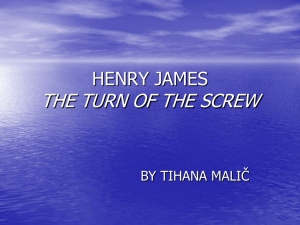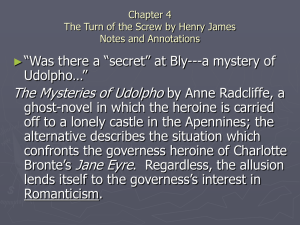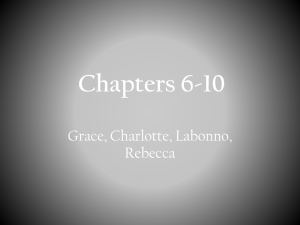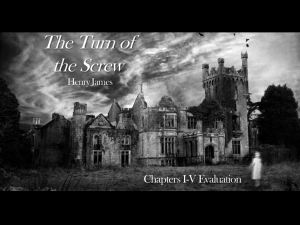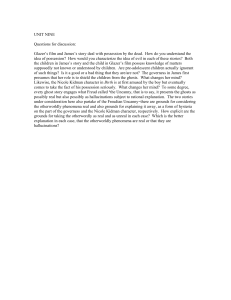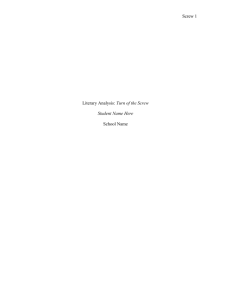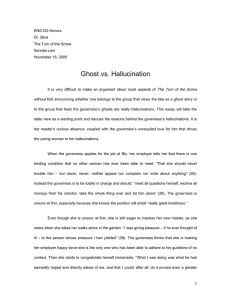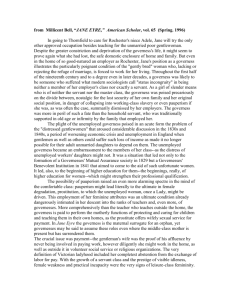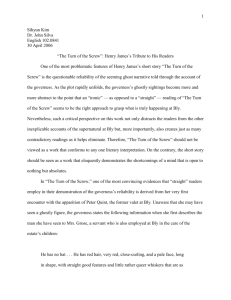THE Turn OF the Screw
advertisement
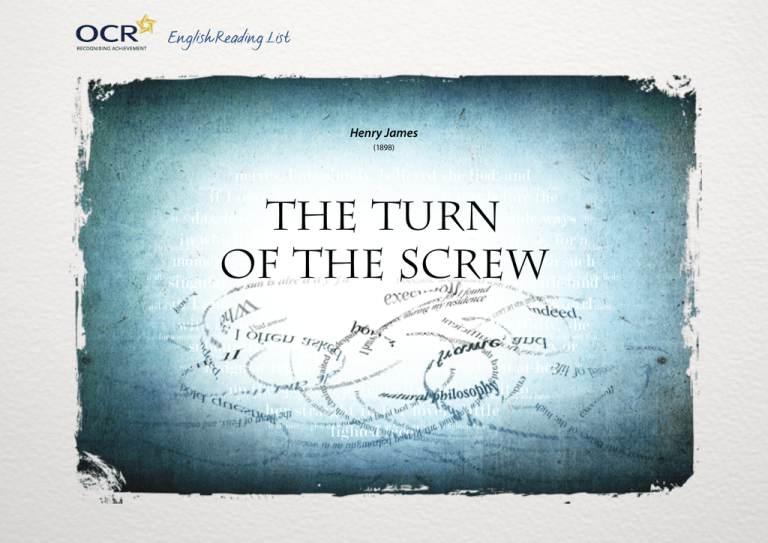
English Reading List Henry James y (1898) y nerves, I absolutely believed she lied; and if I once it was before the up. One of these, forof am s , Issible must have gripped dazzle waysmy little in which these, for a girl with a spasm that, w at her on the spot and have moment, e with such it all over?--give it to he s I bsolutely believed she lied; singular t o withstand must y take little and if Iit, onceI more closed ht this up. girl One of these, with a spas erfully, she for a moment, tempted me little girl with a spasm that, submitted t out a cry or wonderfully, she submitted to with c out at herout on theat spot her and have it all a sign of fright. y ott break break on the and allnotover?--give over?--give it to herspot straight in her or have a sign of fr itWhy break out at her on theit spotto and have her straight in her lovely little it all over?--give it to her straight in her lovely little lighted face? lighted face? more closed my eyes it was bef r the dazzl of the three or four possible ways in which I might take this THE Turn OF the Screw English Reading List Introductions and Suggested Reading These Introductions and Annotated reading lists are intended for teachers preparing to teach this text for the first time for Unit F661 in the OCR GCE AS Level in English Literature, though some materials may be shared directly with students. Most of the concerns highlighted address literary, biographical, historical or other contextual concerns, as indicated in the margin (AO4). Others point to critical approaches that may be juxtaposed with the candidate’s own (AO3). Very occasionally, some help is given exploring the text (AO2), though it is assumed that this work will be carried on in centres. It is the intention that most of this material will be found directly relevant to AS study. Teachers are reminded that Assessment Objectives do not directly establish the quality of an answer, but only assist to place it accurately within an assessment band. It follows that no marks are given directly for demonstration of AOs and that unless properly assimilated into the candidate’s discussion, undigested lumps of contextual material may often inhibit rather than enhance an answer. The brief suggestions for further reading will need to be filtered by teachers before they are presented to students; I would, however, recommend a general textbook on the novel, regardless of your choice of text. This is Jeremy Hawthorn, Studying the Novel (Arnold), which first appeared in 1985, and has been frequently updated and reprinted. Hawthorn’s sense of the history of the novel is astute; his use of examples informative and unthreatening. He is impatient of jargon, and his definition of key‑terms (‘realism’, modernism’) is accessible. Here is a sample of his method. Here he tests the value of successful viewpoint choice: I have tried to find good audio‑book readings of all the novels, convinced that they aid student comprehension more than is generally realised. I also hope teachers will find my views of film versions helpful. No area of A Level study has improved as much as performance‑criticism, where film and television versions (in the case of novels) are viewed by candidates as critical readings of the base‑text. Obviously, this process will be short‑circuited if candidates think of filmed novels merely as pale substitutes for reading, or worse, as substitutes. Please note that where editions of texts are suggested, these are only recommendations. OCR does not specify editions of texts to be used, and F661 is a closed-text examination. > Introductions and suggested reading < English Reading List James in the 1890s I am indebted to Leon Edel, The Life of Henry James (1953‑72). This monumental study constituted its author’s life’s work, and originally appeared in five volumes. It was republished by Penguin in two volumes in 1977. The following references are to Volume 2. Colm Tóibín’s novelised biography, The Master (2004) is also recommended. After his famously unsuccessful experiments as a playwright (in 1895 his drama Guy Domville was hooted from the stage), James felt exhausted by the theatre. He needed an imaginative lift, and found it listening to ghost stories told by the Archbishop of Canterbury in his palatial residence outside London. He was given the germ of The Turn of the Screw, an anecdote of ‘two small children in some out‑of‑the‑way place to whom the spirits of certain “bad” servants were believed to have appeared.’ Listening to the story was not only Henry James, but also the Archbishop’s son, E.F. Benson, who went on to be in his own right one of the most prolific and accomplished writers of ghost stories. James’s own story took a couple of years to ferment. In that time he was moved to rearrange his lifestyle, giving up his comfortable London flat and settling in the ancient town of Rye on the Sussex coast. Names mattered greatly to James, and the similarity of Bly, setting of The Turn of the Screw, is probably not accidental. The imagery, too, suggests he is putting the stage behind him: The place, with its gray sky and withered garlands, its bared spaces and scattered dead leaves, was like a theatre after the performance – all strewn with crumpled playbills. It was also at this time that James bought his first typewriter, and began to dictate his fiction to a professional typist, leading to the elaborate, impressionistic syntax and conversational idiom of his late style. The Turn of the Screw, which was typewritten by an amanuensis, was written in this way, as befits an oral tale, delivered to a group of enchanted auditors by a Christmas fire. > A04 Biographical contexts < English Reading List Special Subject: Innocence James, now in his mid‑fifties and unmarried, not only renewed interest in his living quarters and in modern technology at this time: he wished to revisit the concerns of his youth and childhood, shaving off the trademark beard he had worn all his adult life, and writing a series of stories about innocence and apparently innocent young people, usually under threat. These include Nanda Brookenham, the matter‑of‑fact modern girl in The Awkward Age (1899); the post office girl who is possibly corrupted as worldly telegrams fly across her counter in In the Cage (1898); eight-year-old Maisie cast adrift in the new divorce culture of What Maisie Knew (1897). How much did Maisie know about her parents’, and their lovers’ promiscuous lifestyle?; Fleda Vetch, guardian of the treasures in The Spoils of Poynton (1897) but too nonplussed to tell Owen Gereth that she loves him; above all the menaced children of The Turn of the Screw (1898). Did Henry Ever…? James’s Sexuality and Sexuality in The Turn of the Screw Determining Henry James’s sexuality has proved very vexatious. Some think he slept with both sexes, some with either, or neither. Best, perhaps, to conclude for AS purposes with his biographer Leon Edel that whether James ever consummated a sexual relationship remains ‘not proven’. Whatever he may or may not have done, or been disposed to do, his literary interest apparently stopped at the bedroom door, so explicit meditations on paedophilic exchanges in The Turn of the Screw will certainly not be generated wholly by James’s text. One of James’s more extraordinary confessions was that he found it hard to contemplate what a woman must ‘suffer’ in the marital bed on her wedding night. > AO4 Literary contexts < > A04 Bigraphical context < English Reading List The ‘International’, i.e. American Theme Though setting and characters of The Turn of the Screw are wholly English, James, who was born in New York, and educated (briefly) at Harvard, picked up his fascination with ghost stories in New England, a fertile breeding ground for Gothic tales of the supernatural such as Poe’s ‘The Fall of the House of Usher’ (1839) or Hawthorne’s ‘Howe’s Masquerade’ (1837). This latter story James found quite entrancing, it deals with an entertainment given by Sir William Howe, last royalist Governor of Boston, when Washington laid siege to the town, and which his ghost continued to give, long after his death, on every anniversary ‘of Britain’s discomfiture’. In his Critical Biography of Hawthorne, James is amazed that Hawthorne’s ghostly Governor dances, but his feet emit no sound, as though his antics were condemned to have no further repercussions on the American Continent. Elsewhere in his Hawthorne book, James argues that it takes a great deal of history to produce a little literature. The ghost story clearly proves one of the best means of effecting the transfiguration, as in Hawthorne’s vision of midnight devil‑worship by hypocritical Puritans in ‘Young Goodman Brown’ (1835). It was also in the United States, when James was an infant, that his father was ‘visited’ one night by the devil, or at least by a conception of evil so secure he could describe it in no other way. Though it clearly draws on ancestral shadows of New England, however, The Turn of the Screw is unusual, among James’s novels or novellas, in featuring neither American characters nor settings. > A04 Biographical and literary contexts < English Reading List Recommended Reading The Turn of the Screw in Case Studies in Contemporary Criticism, ed. Peter G. Beidler (1995) is strongly recommended. This contains an admirable summary of biographical materials, including useful accounts of the Victorian ‘religion’ of spiritualism, with which James was familiar, and a discussion of the high esteem with which many rational Victorians regarded the work of the Psychical Research Society. There follows the complete text of the novel, then Beidler’s own account of the critical history of this, the most studied, expounded and commented upon of all James’s texts. Beidler’s analysis begins with contemporary responses to the novella as a genre‑piece (ghost story) dealing with supernatural visitants (hence the interest in spiritualism and the pseudo‑science it generated); then he explores the psychoanalytic readings of Edmund Wilson and others in the 1930s, which often reduce the governess to psychopath or paedophile (‘a subtle antifeminism,’ suggests Beidler,’ that refuses to trust women to be what they say they are’); then synthesises the two in accounts of more recent post‑modern readings which make a virtue of the story’s ambiguity and hospitality to multiple interpretations. This culminates in an astonishing finale in which Beidler marshals no fewer than twenty-six different critical explanations of young Miles’s death, suggesting that possibly ‘any reading is legitimised by the very fact that some reader, somewhere, has offered it.’ I hope I have made clear that this chapter more than satisfies the requirements for A03 at AS level, and will repay careful study. Beidler’s book concludes with five contrasting critical essays on the novel, each from a different theoretic viewpoint: Reader‑Response, Deconstructionist, Psychoanalytic, Feminist and Marxist. Each of these terms is glossed in detail, further enhancing the value of the book for the AS student gathering materials for A03. There are also detailed suggestions for further reading on James, the novel and the critical and contextual fields in which the novella is situated. But above all the beauty of Beidler’s volume is its compression and self‑containment. Students will not need to venture far beyond it. Because of the diversity of his output, and the arguably uncharacteristic status of The Turn of the Screw within it, most book‑length studies of James are likely to prove too long and wide‑ranging to assist the AS student, and most discussions specifically focussed on The Turn of the Screw are listed in Beidler above. Students may, however, wish to seek out the most notorious and influential essay ever written on the novella. This is Edmund Wilson’s ‘The Ambiguity of Henry James’ (1934) in The Triple Thinkers (1948), pp. 88‑132. > A03 Comparing and contrasting different readings < English Reading List Henry James Anticipates Reader‑Response Theory James would not be familiar with modern Reader‑Response theories when he wrote the 1908 Preface to The Turn of the Screw. Yet he seems to delight in the plethora of readings independently minded readers will generate, both in their facility and their danger. He calls his book a ‘trap for the unwary’, confident that the ingenious or prurient imaginations of his readers will do much of the job of making words expressive for him: ‘Only make the reader’s general vision of evil intense enough, I said to myself and that already is a charming job and his own experience, his own imagination, his own sympathy (with the children) and horror (of their false friends) will supply him quite sufficiently with all the particulars. Make him think the evil, make him think it for himself, and you are released from weak specifications.’ This recalls the Garter motto: honi soit qui mal y pense [evil be to him who thinks it]. Reader has turned author. The text starts to say as much about the reader’s preconceptions and preoccupations as it does those of Henry James. Or perhaps considerably more… Students intrigued by the possibilities of Reader‑Response criticism may wish to consult: Wolfgang Iser, The Art of Reading: A Theory of Aesthetic Response (1978). Stanley Fish, Is there a Text in this Class? (1980). > A03 Comparing and contrasting different readings < English Reading List The Ghost Stories of Henry James What constitutes a ghost story generates much discussion, but T.J. Lustig in the World’s Classics edition of The Turn of the Screw identifies no fewer than 14 of James’s Tales as ghost stories, and considers a ghost to intervene substantially in at least two of his major novels, most famously in The Portrait of a Lady (1881; rev. 1906) where Ralph’s ghost shows up at the moment of his death to the woman whose life he has shaped and, arguably, destroyed (1906 text, ch. 55). The living Ralph had previously joked with Isabel that she cannot see the ‘Ghost of Gardencourt’ until she has gained ‘miserable knowledge’. Many of James’s ghosts have, like this one, strong moral or psychological significance, or both. In ‘The Private Life’ (1892) the jolly extrovert poet Clare Vawdry, clearly based on Robert Browning, is never seen at his desk writing a poem. The narrator visits him, late at night, and finds him absent from his room. But there, at the desk, is a shadowy figure: the pen is moving over the paper, and the poems are writing themselves. It is a wonderful symbolic commentary on a poet who seems to put almost nothing of his personality into his writings. Another ‘routine’ ghost is Sir Edmund Orme, in the remarkable story of that name (1891). Whenever his prospective mother‑in‑law’s shady back‑story, or his own wavering motives become uppermost in the narrator’s consciousness, in walks Sir Edmund, the dead fiancé of his wife‑to‑be. The ghost is a creature of perfect propriety, dressed to the nines, and does nothing worse than claim a seat at the end of a church pew. But he is, for all that, a terrible visitant, a guardian of sexual ethics, perhaps the embodiment of Victorian ethics themselves. What these stories demonstrate is that James was capable of invoking the supernatural without a hint of ambiguity or irony to make a sufficiently tough psychological point. In ‘Sir Edmund Orme’ the narrator is quite as limited and flawed in his outlook as the girl‑governess in The Turn of the Screw; but it is the business of the guardian‑ghost, with his immaculate sense of timing and decency, to keep him in order, and possibly Peter Quint and Miss Jessel, whom James himself likened to ‘goblins’ rather than ghosts, have a minatory function too. Certainly there is nothing wispy or unsubstantial about the majority of James’s ghosts: one critic thought Peter Quint resembled the emphatic Bernard Shaw; Clare Vawdry’s alter ego writes a huge ledger of Collected Poems. And James liked writers who could combine the mundane with the toughly supernatural. In an essay on Honoré de Balzac, he explores the French novelist’s passion for solidity, ‘for material objects, for furniture, upholstery, bricks and mortar’, but notes how often he uses these ‘solid objects’ as a setting for ghosts. > A04 Literary contexts A02 Close reading < English Reading List OCR examiners have noted that F661 answers are often improved by intertextual engagement with short stories written by the author of the assigned text, so it might be useful to introduce comparisons between The Turn of the Screw and some of the texts listed above. Other impressive ghost stories you might choose include ‘The Friends of the Friends’ (1896) (people who see ghosts should meet up with one another) and ‘The Jolly Corner’ (1908) (older and younger selves confront one another in the mirror). How does the Governess Know What Quint Looks Like? The short answer is that she sees his ghost. When Quint appears first, on the ‘gingerbread’ tower (ch. 3), she assures us she has not seen his face ‘anywhere’ before. He is nothing like his former master, her employer in Harley Street, or anybody in the house, and he stares at her, albeit from a considerable distance, with challenging familiarity. In the next chapter she sees his face at the window, and though she does not tell us then what he looks like, she tells Mrs Grose immediately afterwards about his curly red hair and pointy side‑whiskers, and the housekeeper undoubtedly recognises the description (ch.5). Yet not everyone is satisfied with the governess’s explanation. After all, the girl also says ‘Quint was there or was not there; not there if I didn’t see him.’ In Truman Capote’s (and others’) screenplay for The Innocents, the governess’s first direct view of Quint’s distinctive features comes not gibbering through a window‑pane, but from an old cracked photograph the governess discovers in the attic. Critics who believe the governess invents and develops the ‘horrors’ and thus wish to short‑circuit the effect of the ghosts, tend to posit an additional scene, to the same effect as Capote’s, in which the governess, at the beginning of her stay at Bly, picks up hearsay about the Master of Bly’s notorious ex‑valet. Whether it is fair to presume such a scene seems questionable, James did not write it, and any novel could be modified in this way to suit the critic’s preconceptions. It seems more likely that James wrote a ghost story in which the ‘great house’ of Victorian fiction is haunted by both supernatural and human imaginations. But, as with everything in this profoundly ambiguous novel, it is up to the reader to judge. > AO2 Close reading AO4 Opinions of other readers < English Reading List Spare a Thought for the Governess Most of James’s fiction is set at the present time, or in the near‑past. The Turn of the Screw is an exception. It seems to be set around the 1840s, the decade of James’s birth. This may partly be to lock on to the ‘long ago and far away’ mystique of the ghost story; or it may be to accent what seem deliberate allusions to the world of the Brontë governesses, Jane Eyre and Agnes Grey. Like the governess in James’s story, Brontë governesses are characterised by their isolation, vulnerability, quavering half‑defined sexuality, and sense of injustice and menace. Both Charlotte Brontë’s Jane Eyre and Anne Brontë’s Agnes Grey were published in 1847, very much James’s target period in The Turn of the Screw. The Gothic atmosphere of The Turn of the Screw recalls both Brontë novels, and the governess names Mrs Radcliffe’s classic Gothic novel, The Mysteries of Udolpho, an influence on several Brontë novels, and refers more obliquely to the possibility of ‘an insane, unmentionable relative’, like Bertha Mason, ‘kept in unsuspected confinement’ (ch. 4). Bly, Udolpho and Jane Eyre’s Thornfield all conceal unpleasant secrets, but only James’s governess apparently battles actual ghosts. As compensation, Brontë governesses run up against some of the nastiest, least biddable children in fiction, where James’s are ‘of a gentleness so extraordinary.’ Agnes Grey has to herd her recalcitrant charges into the corner of the room, and keep them there by holding an open textbook across the angle. One of them, a little boy whose hobby is torturing baby birds, makes Miles’s dodgy epithets look positively angelic. Nominally on a level with her employer in terms of class, and therefore superior to other servants, the governess found herself isolated in the world of the great house, in it but not really of it, nor able to access its engines of power. Agnes can only fight back at her brutal pupil by crushing the birds with a stone slab to prevent their suffering further. In Jane Austen’s Emma (1815) a sensitive young woman forced to work as a governess, compares the situation of the ‘governess trade’ to the ‘slave trade.’ The difference, presumably, was that the slave trade had recently been suppressed. Part of the irony of James’s story is that a naïve girl from a Hampshire vicarage is suddenly pitched by an irresponsible master into more or less full charge of a great house with a dark past and deeply impressionable inhabitants. Miles, dressed to the nines by his uncle’s tailor, seems in the churchyard scene (ch. 14) to resent the oppressively feminine atmosphere the governess inculcates at Bly. He is ‘a fellow’ ‘who is getting on’ and who needs ‘more life’ and ‘his own sort.’ This worldly appetite only makes her, of course, more resolute to defend his ‘innocence’ to the last ditch. Governesses can’t win. > AO4 Sociological and literary contexts < English Reading List The Ambiguity of Henry James 1) Sea of Azov One of the scenes where the reader’s imagination is inveigled most powerfully into the ‘horrors’ – or possible horrors – of Bly is the ‘Sea of Azov’ scene in ch. 6, when Miss Jessel appears on the far side of the lake. The governess describes Flora putting together pieces of wood to form a boat: She had picked up a small flat piece of wood, which happened to have in it a little hole that had evidently suggested to her the idea of sticking in another fragment that might figure as a mast and make the thing a boat. This second morsel, as I watched her, she was very markedly and intently attempting to tighten in its place. Critics, possibly under pressure from the governess, frequently detect sexual symbolism here: that Flora is re‑enacting lessons in human biology that she learnt at the hands of Quint and Miss Jessel, possibly accompanied by them with practical demonstrations. But all this might just be in the reader’s mind. Flora might be innocently preparing to sail a model boat over an imaginary Sea of Azov, recalling nothing more sinister than the governess’s geography lesson. And the governess? It is at this stage in the story that she starts to speculate ‘how the deuce’ she might ‘get out of it’ if she were to introduce into the perfect imaginings of childhood ‘an element so dire’. 2) Schoolroom From this point, the governess has a vested interest in seeing ghosts, and in pinning on them the ‘horrors’ of Bly. If the ghosts are real, and still oozing their sexual putrefaction-like pestilence, then they must be exorcised; if not, then her own virginal imagination is creating the blight: unthinkable in a well‑brought up young lady in the evangelical 1840s. Like the ‘Sea of Azov’ scene, the encounter with Miss Jessel in the schoolroom (ch. 15) is interpreted by critics in mutually exclusive ways. Those who doubt the governess don’t doubt that she invents the content of her interview with the ghost; those who sympathise with her tend to argue that when she later tells Mrs Grose (ch. 16) that Miss Jessel’s communication was equivalent to human talk, she has genuinely received an ‘intimate impulse’ from the other world, much as spiritualistic mediums received messages as to their contacts’ woe or pain. Not that Miss Jessel is likely to have spoken of her damnation in so many words, indeed the governess’s description of the scene in ch. 15 suggests that she is silent, resolute and proprietorial. But the governess becomes strongly convinced she has evidence on which to proceed. > AO2 Close reading AO3 Opinions of other readers < English Reading List The Ambiguity of Henry James 3) The Conclusion From this point the governess behaves as though the ghosts have free access to all apartments in the house, and have become Miles and Flora’s chosen playmates. Mrs Grose, who can’t read, respects the governess as a peasant might a learned conjurer, and gives her more‑or‑less a free hand. The governess, in her turn, gives the ghosts inarticulate messages of gratitude for proving her ‘neither cruel nor mad.’ The mad governess school find nothing surprising in Miss Jessel’s non‑appearance in chs. 19‑29 to either Flora or Mrs Grose: for them Miss Jessel is a (dangerous) figment of the governess’s imagination. But another reading is tenable. Flora has become ‘possessed’ by the spirit of Miss Jessel, who is directing her actions, forcing her to lie about what she has or has not seen, and corrupting her words so they sound like those of a ‘vulgarly pert little girl in a street’. The governess is convinced that ‘each stabbing word’ comes ‘from some outward source.’ Miles’s famous last words are often held to be the most ambiguous of all in this ‘irresponsible’ novella. ‘Peter Quint – you devil!’ he says. This could be glossed 1) ‘You mean the infernal Peter Quint who inspired all my foul language is here!’ or 2) ‘You, devil governess, why are you blaming all this on Peter Quint?’ At the end of the novella, in which the governess claims to have ‘dispossessed’ (i.e. removed the possessing spirits from) the heart of little Miles, that heart has unarguably stopped. What is never resolved is whether it stopped under human or supernatural pressure. James’s ambiguity, writing on a subject, the existence of ghosts, that has divided opinion for centuries, is controlled, deliberate and highly creative. > AO2 Close reading AO3 Opinions of other readers < English Reading List Where Next? There has been much speculation about how the governess managed to live with herself after she had arguably precipitated all those disasters at Bly. James’s answer would probably be that, as is his wont, he had provided data for establishing this within his text. He did not like to bring his characters back for second helpings in second volumes, and rarely did so. ‘Really, universally, relations stop nowhere,’ James famously wrote in his Preface to Roderick Hudson. For this reason the artist needed, by a ‘geometry’ of his or her own, to draw a circle that would best fit the lives of the characters he was handling, and mark the limit of his book. James was not fond of consigning his characters at the end of the story to vague suggestions of future possibilities. The presentation should consume the human potential of the figure. So the governess never did land the Master of Bly, however sincerely she may or may not have yearned for him; she is not fatally marked by the events at Bly, for she continues as Douglas’s governess; and her instability in the story has not cancelled her charm for the young: Douglas thinks her ‘awfully clever and nice.’ Thus the unnamed governess, who does not live long anyway, and died a generation before her story is told, does not need ‘bringing back’: she disappears into anonymity, considerable, professional, conventional. From one point of view, then, this is a ‘rite of passage’ story, charting the governess’s development from girl to woman. > A02 Textual analysis < English Reading List Film and Audio Versions The Turn of the Screw has generated at least one great film treatment, The Innocents, produced and directed by Jack Clayton in 1961, and featuring notable performances (among others) from a precocious Pamela Franklin as Flora and Deborah Kerr as an older than usual governess. The atmospheric black‑and white cinematography and evocative soundtrack (nursery rhymes, rook‑caws, hissing trees) are deliberate antidotes to contemporary Hammer horror films with their lurid Technicolor and pounding music. The ghosts are introduced with quite chilling obtuseness, especially that of Miss Jessel. Truman Capote helped with the screenplay, imparting a faint but unmistakeable flavour of Southern Gothic. A very workmanlike adaptation came to television in 1999, distinguished by an inscrutable Colin Firth, looking like a Brontё hero, as the Master of Bly, casting a spell over Jodhi May’s wide‑eyed, open‑mouthed governess. In contrast to the earlier film, this has a primary colour heritage look, and the ghosts are very solid. Quint at the window looks like a surveyor inspecting for dry rot. Both 1961 and 1999 films are satisfyingly brief, each running for under 100 minutes. Other television versions were produced in 1974, starring Lynn Redgrave as a very brisk, managerial governess, and, most recently, in 2009. This one lurches into the exploitative, with demonic children and Sue Johnston’s Mrs Grose covering up her household’s dark past. Set in 1921, the First World War has made a clean sweep of all men at Bly save the dead but decidedly potent Quint. Though the screenplay does away with all of James’s subtlety and most of his ambiguity (there is a second frame narrative in which the criminally insane governess tells her story to a mad doctor) Michelle Dockery’s performance in the central role is the best so far: all queasy primness, with a face like a Victorian poetess. The Turn of the Screw is available as download, as MP3 and on CD from various sources. The Tantor Audio Classics version is unabridged and runs for about five hours, reader Anne Flosnik. The novelist Ford Madox Ford, a friend of James and collaborator with Joseph Conrad, contended in his Memories and Impressions that the only way to come to terms with James’s late style was to read the prose aloud; it may, therefore, help you to come to terms with the text of this novella to hear it read aloud as a talking book. > A04 Comparing and contrasting different treatments <
